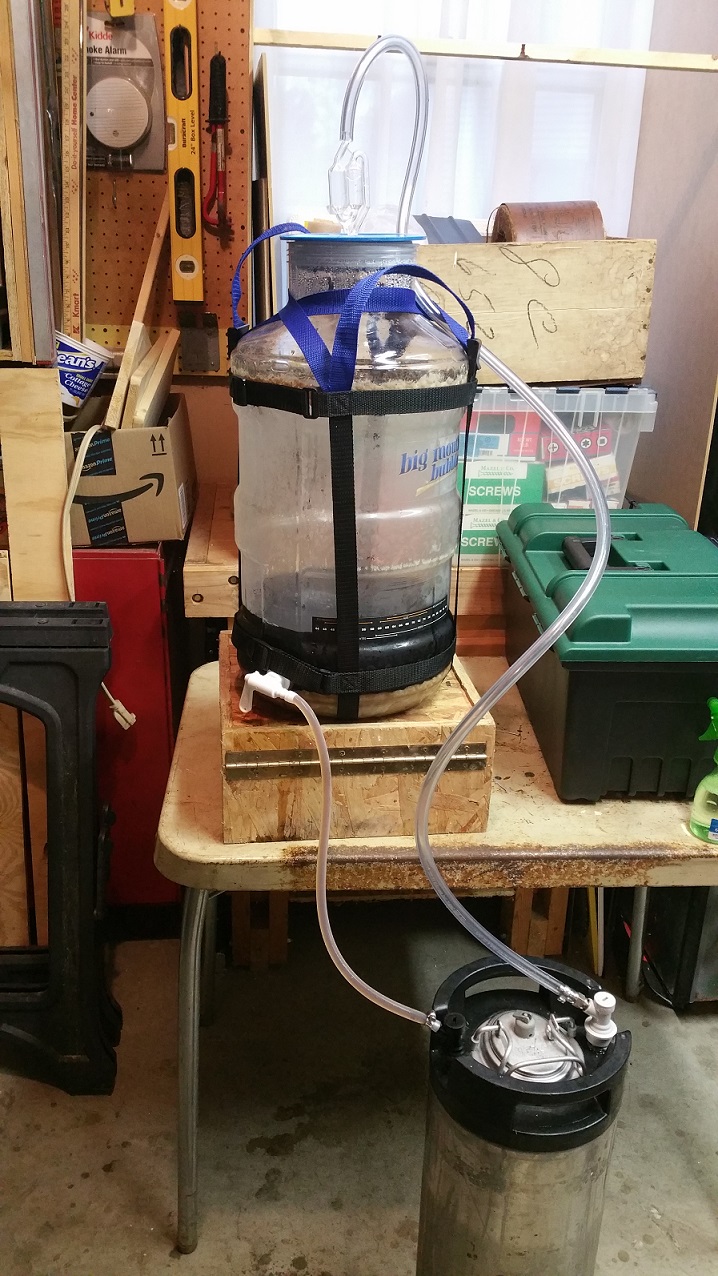I did some fermentations in a glass carboy, but didn't take long to switch to the ported plastic BMB: 1) lighter 2) no chance of catastrophic breakage/injuries. 3) I love the port/spigot drain.
Anyhow, I can't find an example right off of someone doing a low oxygen transfer with one, and I think that one disadvantage it might have vs. the carboy is that the top will be less able to contain pressure (any pressure at all) but I think I'm about to find out.
My normal transfer setup is to put the BMB up on the counter, pull the airlock, and gravity drain through the spigot, through the removed lid on the keg. So far I've made no attempt to flush air from the keg, so despite my best efforts there is some turbulence in the keg, until the end of the hose is submerged about an inch. I'm sure there is opportunity for some oxygen uptake here. Also, the fermenter is drawing in air from above that will be gradually mixing with the existing C02. No turbulence though.
So of course I want to purge the keg, probably a full liquid purge. I'm trying to figure out the best plan on exactly what I can do with the equipment I have. Questions:
1) On the actual drain into the keg: I see a lot of people use pressure to push liquid in through the liquid port. Is gravity alone enough pressure for this? Keep in mind most of my beers are dry hopped and currently not cold crashed, so some hop debris will be present. Not much, and I don't normally consider it a problem, but with that tiny little post opening with very low pressure, I'm wondering.
2) If a transfer through the liquid port is unlikely to work in this scenario, is it worth it to bother purging the keg if I'm going to have to take the lid off anyway? I could purge the keg, then take the lid off and transfer quickly, just make sure the surrounding air is as still as possible to prevent mixing (ceiling fan off, no breathing in it etc). Draining into the bottom, hopefully that would still give some benefits in terms of less opportunity for oxygen uptake?
3) How bad is it to let air into the top of the fermenter during the transfer? Ideally I would like to figure out a way to hook up the gas to the top of the fermeter and just barely crack it open, maybe to 2 PSI or something, but I haven't looked to see if I can actually do that with the gear I have, and I'm not sure if the BMB lid would be gas-tight even at 2 PSI. If I had some seepage just during the transfer time, it probably wouldn't waste all that much gas though.
Thoughts on the best thing to do with my current equipment?
Anyhow, I can't find an example right off of someone doing a low oxygen transfer with one, and I think that one disadvantage it might have vs. the carboy is that the top will be less able to contain pressure (any pressure at all) but I think I'm about to find out.
My normal transfer setup is to put the BMB up on the counter, pull the airlock, and gravity drain through the spigot, through the removed lid on the keg. So far I've made no attempt to flush air from the keg, so despite my best efforts there is some turbulence in the keg, until the end of the hose is submerged about an inch. I'm sure there is opportunity for some oxygen uptake here. Also, the fermenter is drawing in air from above that will be gradually mixing with the existing C02. No turbulence though.
So of course I want to purge the keg, probably a full liquid purge. I'm trying to figure out the best plan on exactly what I can do with the equipment I have. Questions:
1) On the actual drain into the keg: I see a lot of people use pressure to push liquid in through the liquid port. Is gravity alone enough pressure for this? Keep in mind most of my beers are dry hopped and currently not cold crashed, so some hop debris will be present. Not much, and I don't normally consider it a problem, but with that tiny little post opening with very low pressure, I'm wondering.
2) If a transfer through the liquid port is unlikely to work in this scenario, is it worth it to bother purging the keg if I'm going to have to take the lid off anyway? I could purge the keg, then take the lid off and transfer quickly, just make sure the surrounding air is as still as possible to prevent mixing (ceiling fan off, no breathing in it etc). Draining into the bottom, hopefully that would still give some benefits in terms of less opportunity for oxygen uptake?
3) How bad is it to let air into the top of the fermenter during the transfer? Ideally I would like to figure out a way to hook up the gas to the top of the fermeter and just barely crack it open, maybe to 2 PSI or something, but I haven't looked to see if I can actually do that with the gear I have, and I'm not sure if the BMB lid would be gas-tight even at 2 PSI. If I had some seepage just during the transfer time, it probably wouldn't waste all that much gas though.
Thoughts on the best thing to do with my current equipment?



